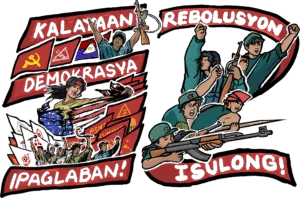V. Chinese people are fighting back
As I stated above, the Reform has educated the Chinese people on what capitalism really is through their experiences during the past thirty years. No one really believes anymore that China is still a socialist country. The attacks launched by the Reformers on China’s working population have been brutal and relentless. The process of destroying the socialist economy by forcing former State workers into waged labor in the industrial sector, and forcing peasants off the land to work as migrants is similar to the primitive accumulation phase of early capitalist development in European countries. There is, however, an important difference: primitive accumulation in Europe was able to release labor from the control of the feudal lords. In China, workers and peasants have already gone through thirty years of socialist transformation, and they know what they can accomplish by working collectively under the leadership of the real Communist Party following the proletarian line of Mao Zedong.
In the past 15 years, more and more people have been organizing themselves in resisting Reform policies. Many laid-off workers take over their factories to protest against their sale and/or closing. Older workers forced into retirement have protested against authorities for back wages and for better benefits. Peasants protest against land confiscation without adequate compensation and against factories being built in their neighborhoods that cause serious pollution. Many people both in urban and rural areas have protested against the brutality of police and local officials. In 2005, the official numbers of demonstrations involving 100 or more people reached 200 to 300 a day, or 74,000 over the year. By 2006 the figure reached over 90,000, after which the government stopped publishing the data – undoubtedly because the number has continued to rise.
Also important is the increasing numbers of intellectuals who have risen to challenge the many lies broadly spread by the Reformers. Many of these intellectuals were fooled in the early stages of the Reform, believing the line that the Reform was “socialism with Chinese characteristics”. Many, including some who had joined the 1989 student movement (ending in the Tiananmen Massacre), also believed that the free market approach would solve many of China’s problems.
In the last 15 years, progressive intellectuals started to challenge the Reformers by refuting many lies told by them. For instance, the Reformers claimed that there was little development during the socialist era, but these intellectuals proved that the opposite was true by publishing data showing tremendous accomplishments during the thirty years before the Reform. The Reformers have also falsely claimed that China’s development based on self-reliance during the socialist era was self-imposed isolation, which led to China’s backwardness. These intellectuals have repudiated such claims, accusing Reformers of being over-dependent on foreign capital, foreign technology, and foreign markets, handing the country over to the foreign monopolies, and causing China to lose its economic and political autonomy.
In the past two years, discussion and debate in China, online, in publications, and in public forums, have been lively and intense. The scope and the depth of these discussions and debates have been much wider and deeper than anytime since the Reform began. Attacks on the Reform have also become much bolder and more direct, putting those who still advocate continuing the Reform on the defensive.
In a letter written and signed by 170 prominent people in September 2007, and submitted to the Delegates of the upcoming 17th Congress of the Chinese Communist Party, the signatories openly charged that power holders of the Chinese Communist Party no longer represented the interests of China’s proletariat, and that they betrayed the principles of Marxism, Leninism, and Mao Zedong Thought11. Developments in the past two years show the forces opposing China’s capitalist Reform are gaining strength. Although there is no doubt that the struggle for socialism in China, like elsewhere is going to be long, hard, and treacherous. China’s socialist legacy and the theory and practice Mao left behind will carry the struggle to triumph in the end.
References
Bai Jing-fu, “The Main Contradiction of Out Country’s Economic Growth during the 11th Five-year Plan,” http://theory.people.com.cn
“Letters to the Delegates of the 17th Congress of the CPC: The Voice of the People, September 19, 2007,” Institute of Political Economy Journals, January, 2008
Pao-yu Ching, “An Analysis of China’s Capitalist Reform,” Institute of Political Economy Journals, December, 2006
Pao-yu Ching, How Sustainable is China’s Agriculture? A Closer Look at China’s Agriculture and Chinese Peasants, published by People’s Coalition on Food Sovereignty (PCFS) and the Pesticide Action Network Asia and the Pacific (PAN AP), August 4, 2008 (PAN AP: http://www.panap.net/15.0.html and PCFS: http://www.foodsov.org/html/resources.htm)
NOTES:
1 Foreign exchange reserves are mostly in US dollars, foreign bonds and securities, such as US government bonds and Treasury Notes, as well as the bonds of the recently troubled Fannie Mae and Freddie Max. Even though China’s trade surplus has decreased in the past year the foreign exchange reserves has continued to go up. One explanation is the inflow of foreign capital and a large part of that inflow could be for speculative purpose.
2 See: Pao-yu Ching, “An analysis of China’s Capitalist Reform, Institute of Political Economy Journals, November, 2006, 3-42.
3 For Bai Jing-fu’s report, see references.
4 Some migrant workers also try to earn a living by working as street vendors.
5 The plot of land each peasant household received was small to begin with and it was further divided into five to ten pieces ranging from high to low quality of land.
6 A documentary made in 2003 called “The Iron Reapers”, showed many poor peasants work as hand reapers during the harvesting season in areas that are hard to reach by combine. These peasants compete with the machines by lowering their price to 35 RMB per mu. The film showed four men leaving home by long distance bus with their hand reapers to harvest wheat. Each man working a 12 hours day in the hot sun harvested an average of 1.5 mu land and earned about 45 RMB for the grueling back-breaking work. Some days they did not get work, so after the whole harvesting season, each man came home with less than 200 RMB. (Iron Reapers, a documentary, 2003)
7 There is no report on exact land loss figures since the Reform, however, it has been reported that rate of land loss has accelerated reaching 2% of arable land in 2003. The Worldwatch gave a lower estimate for the amount of land loss during the years since the 1979 reform – a half-million hectares each year, or about one-third of 1 percent. The total land loss over a period of 25 years amounted to 7 percent of the total agricultural land. The Worldwatch estimate fails to show the upward trend of the more recent years. (Worldwatch, 15) See Ching, 2007.
8 It is a form of welfare relief – a small cash payment to help the extreme poor. The amount is about 130 RMB for city and town residents. The amount is unknown for rural residents.
9 Nationally, 900,000 people have been infected by the disease and an estimated 30 million are no at risk. (New York Times, February 23, 2005)
10 For detailed references see Ching, 2008. In 2006 the Worldwatch also provided an estimate of the total land loss since the Reform to be around 7. (See Worldwatch, 2006, 15)
11 The English translation of this letter was published by the January Issue of Institute of Political Economy Journals, IBON Center, The Philippines.

